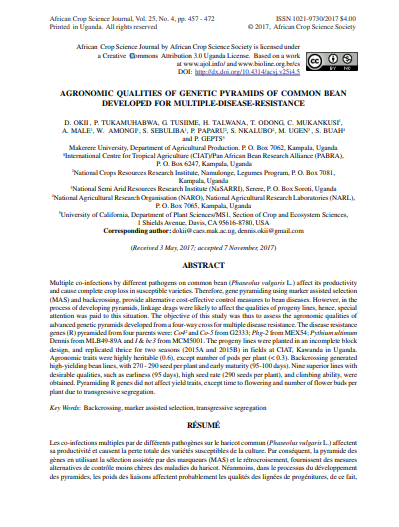Agronomic qualities of genetic pyramids of common bean developed for multiple-disease-resistance
Summary
Multiple co-infections by different pathogens on common bean (Phaseolus vulgaris L.) affect its productivity and cause complete crop loss in susceptible varieties. Therefore, gene pyramiding using marker-assisted selection (MAS) and backcrossing provide alternative cost-effective control measures to bean diseases. However, in the process of developing pyramids, linkage drags are likely to affect the qualities of progeny lines, hence, special attention was paid to this situation. The objective of this study was thus to assess the agronomic qualities of advanced genetic pyramids developed from a four-way cross for multiple disease resistance. The disease resistance genes (R) pyramided from four parents were: Co42 and Co-5 from G2333; Phg-2 from MEX54; Pythium ultimum Dennis from MLB49-89A; and I & bc3 from MCM5001. The progeny lines were planted in an incomplete block design, and replicated thrice for two seasons (2015A and 2015B) in fields at CIAT, Kawanda in Uganda. Agronomic traits were highly heritable (0.6), except number of pods per plant (< 0.3). Backcrossing generated high-yielding bean lines, with 270–290 seeds per plant and early maturity (95–100 days). Nine superior lines with desirable qualities, such as earliness (95 days), high seed rate (290 seeds per plant), and climbing ability, were obtained. Pyramiding R genes did not affect yield traits, except time to flowering and number of flower buds per plant due to transgressive segregation.
Open resource Download resource Access resource on external site

